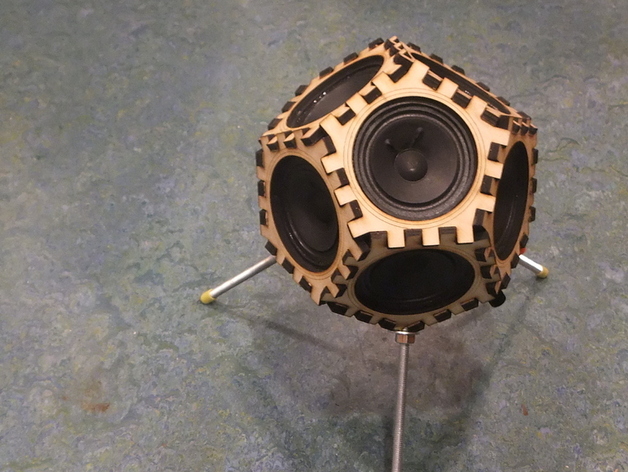
Sputnik 17: Dodecahedron loudspeakers
thingiverse
Dodecahedron loudspeakers radiate sound in all directions. They also look really cool. This project uses a parametric program that allows anyone to create a dodecahedron loudspeaker using any size speaker. We chose three-inch speakers since they were inexpensive and available. Hope you enjoy! Update: there is a revised version of this project at: http://www.thingiverse.com/thing:21272 which includes an improved generator script. Thanks! Instructions Introduction A dodecahedron is a 12 sided object made up of 12 identical pentagon faces. It makes for an interesting speaker cabinet because the angle of the faces of the cabinet is close to the ideal angle of the sound radiated by a speaker. (Or so I was told in a classroom many years ago.) Since the loudspeaker is made up of 12 faces, it requires 12 speakers, one for each face. This can get pretty expensive since a typical stereo setup has two loudspeakers (24 faces) - more if you are doing surround sound! These speakers are best used in settings where radiating sound in all directions is a virtue - this is not something that a typical stereo loudspeaker cabinet is designed to do. We use them in our shop, a narrow room where they are hung toward the center of the room. Design The first thing to do is decide how large a speaker you wish to use. As a practical matter we selected an inexpensive 3 inch speaker from Jameco (part number 1954800). The speaker must be round, and the impedance should ideally be in the 4-16 ohm range. 8 is the most typical speaker impedance. There is a practical limit to how large a speaker can be due to the workbed of the laser cutter you plan to use. The laser cutter that we have access to (at Metrix in Seattle) has a maximum cutting range of 11 x 17 inches, so making a huge subwoofer with 12 inch speakers is out of the question. (Although an interesting idea!). We made the hole in the pentagon 1/10th of an inch smaller than the speaker so that there was a lip for the speaker to rest on. Material Next, decide on the material you wish to use. 1/4 inch birch ply seems pretty standard for laser cutting, although you might want to experiment. Plastic and solid wood are also options. The thickness of the material will affect the length of the finger-joints. (Update) we have had trouble cutting all the way through 1/4 (6mm) baltic birch ply, so we may do a second series with 3 or 4 mm ply. (This will require a new template file since thickness affects the finger length.) You can either accept the 3 inch speaker size and work with the same template.SVG file that we used, or you can strike out on your own (go for it!) and use the python program to create a new template file for a custom size speaker. The program takes several parameters and generates a new .SVG file containing your template, customized for your parameters. Its' actually kind of fun to play around with the script and see what effect of different values like thickness and number of teeth. Cutting Once you have a template you approve of, it's time to cut. We started out with three sample pieces, and test-fitted the speakers and then did a trial assembly. In the process we discovered that the math was a little off and the fingers of the template were too long (which made for difficult assembly). We fixed this problem and returned a few days later to cut some more pieces. Again we cut three trial pieces and assembled. After those were confirmed, we cut 21 more pieces. The cutter had issues with a combination of our template and the 1/4 ply, and we only were able to harvest 12 - enough to get one speaker made as a trial run. Wireing (One note on speaker wiring - our speakers are 16 ohm, and need to be wired in some combination of series and parallel to get a final impedance that is in the acceptable range (roughly 4 to 16 ohms). We have chosen to wire four sets of three speakers in series, then combine these four chains of speakers together in parallel. This gives a final impedance of 12 ohms - a little lower than one speaker, but higher than the industry standard of 8 ohms.) The finished speaker in 3D? If you look in the files section there is a file with the extension MPO. This is a 3D image format for the few of you who have some way to display it in 3D. Enjoy! Next Steps Inexpensive 3 inch speakers can only do so much - although adequate, the bass is weak and the overall sound is a little tinny. Next step is to use 4 inch speakers and thinner plywood that should cut better. Updates to come! Update: there is a revised version of this project at: http://www.thingiverse.com/thing:21272 which includes an improved generator script. Thanks for your interest!
With this file you will be able to print Sputnik 17: Dodecahedron loudspeakers with your 3D printer. Click on the button and save the file on your computer to work, edit or customize your design. You can also find more 3D designs for printers on Sputnik 17: Dodecahedron loudspeakers.
